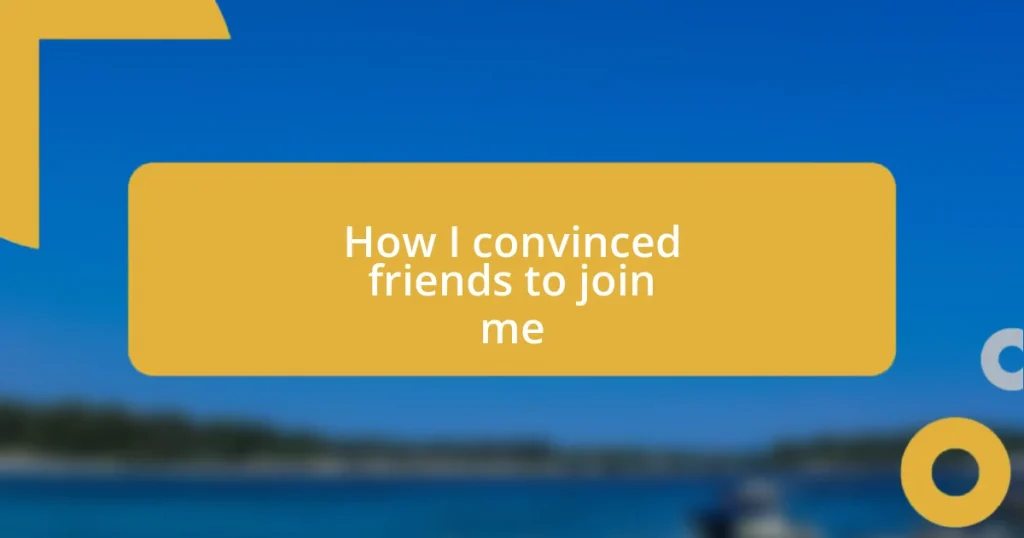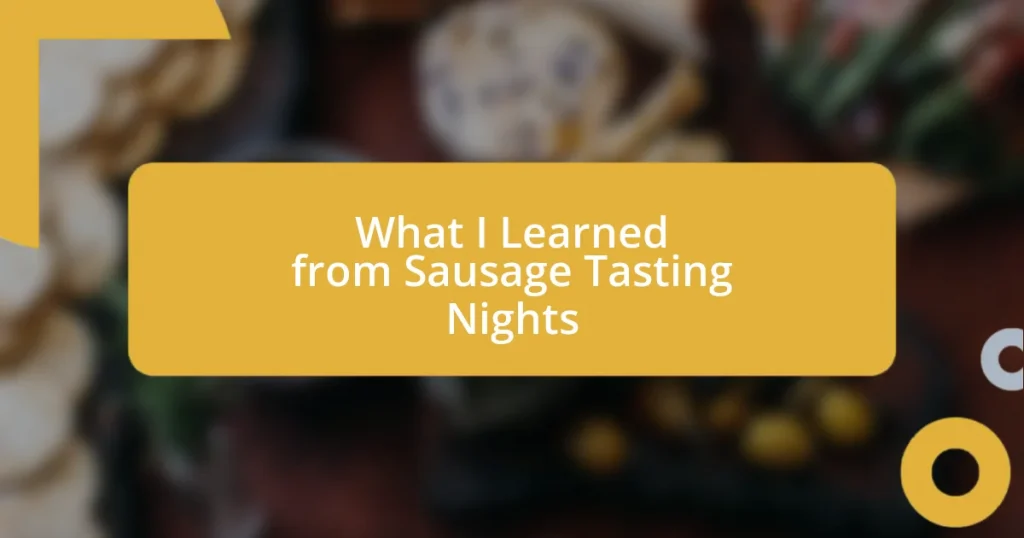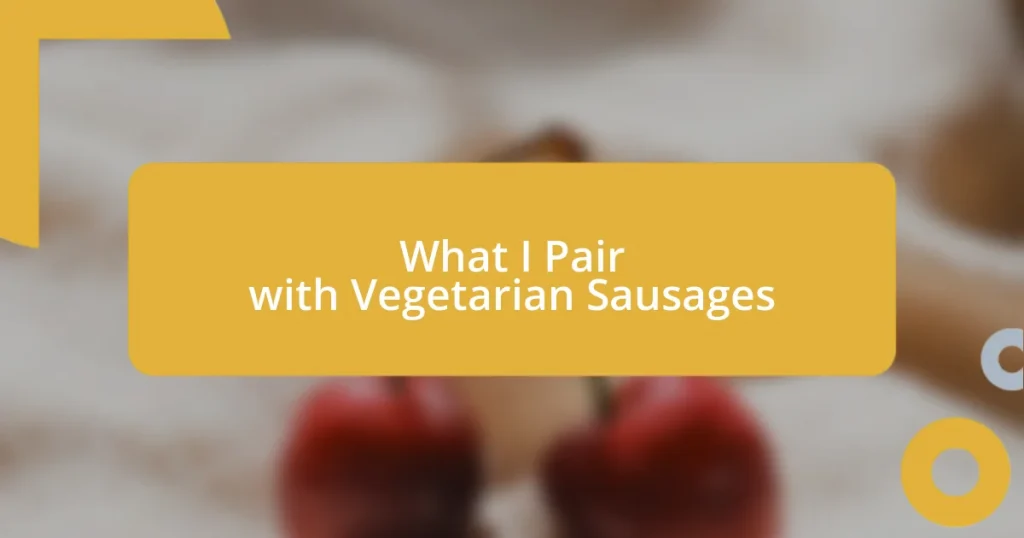Key takeaways:
- Persuasion is more effective when it connects with emotions and shared goals, fostering deeper relationships and collective excitement.
- Identifying shared interests through casual conversations and observations strengthens bonds and encourages participation in activities together.
- Addressing concerns transparently and maintaining enthusiasm through follow-up communication and personalized touches enhances engagement and leads to memorable experiences.
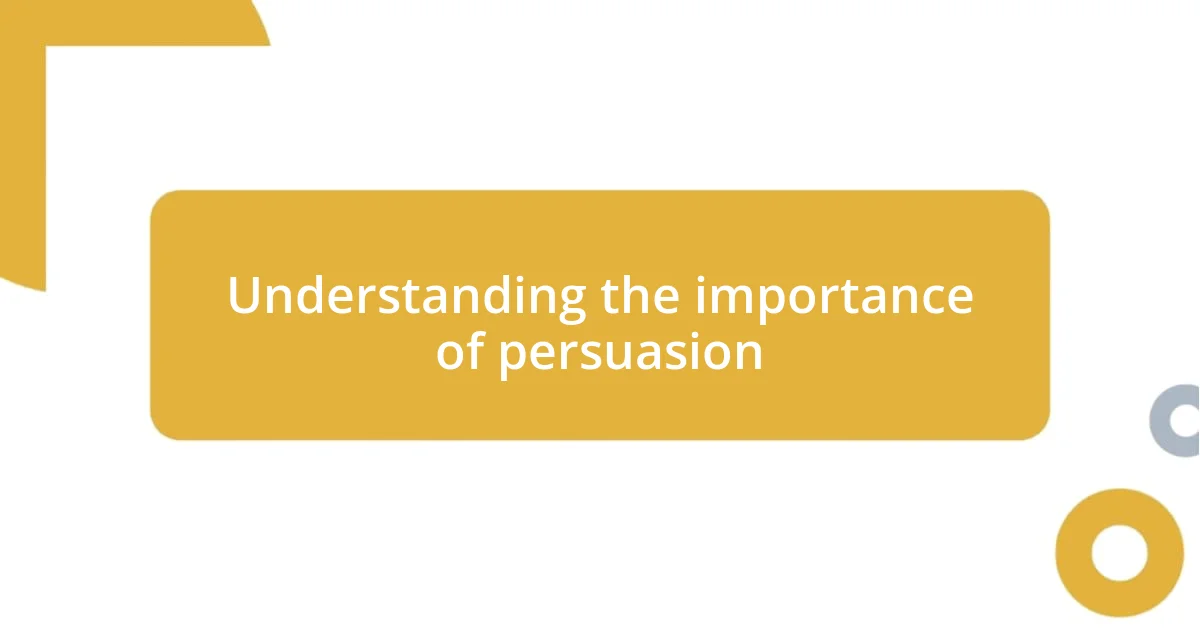
Understanding the importance of persuasion
Persuasion is a powerful tool that extends beyond mere communication; it’s about connection and influence. I remember the first time I tried to convince a friend to join me for a hiking trip. I didn’t just throw facts at her about the trail or the views; I tapped into her love for adventure and shared my excitement about experiencing nature together. Isn’t it fascinating how appealing to emotions can lead to a richer dialogue and ultimately, a shared experience?
The significance of persuasion lies in its ability to create shared goals. Think about a time when you were genuinely motivated by someone else’s enthusiasm. I once had a friend who was hesitant about a book club I started. By discussing how much we all could learn and grow together, I saw her curiosity spark—and that single moment not only convinced her but ignited a greater passion within our group. Have you ever noticed how collective excitement can amplify an idea?
Furthermore, understanding persuasion helps in fostering relationships. In my experience, when people feel understood and valued, they are more likely to be open to new experiences. I’ve often found that listening actively and responding with empathy can transform skepticism into eagerness. How do you think our connections change when we genuinely engage in understanding others’ perspectives?
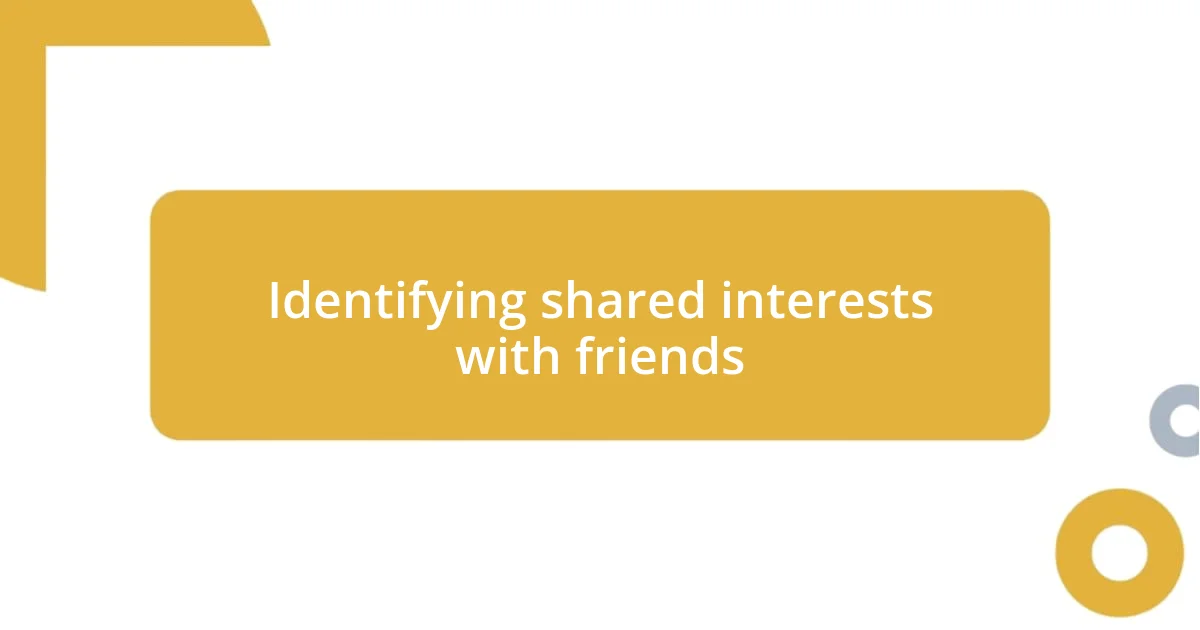
Identifying shared interests with friends
Identifying shared interests with friends is like uncovering hidden gems that strengthen bonds. When I first started exploring photography, I casually mentioned it to a friend who also had a budding interest. As we discussed our favorite subjects and techniques, I realized how much more fun it was to practice together. Sharing that experience made our friendship deeper and allowed us to cheer each other on.
To effectively identify mutual interests, conversations are key. I remember a lively dinner when the topic of travel came up. I simply asked everyone about their favorite travel destinations and soon discovered that several of my friends shared a love for beach vacations. This sparked a group trip that bonded us even more, as we laughed while planning our itinerary and reminisced about previous adventures. Have you ever noticed how simple questions can shift the vibe entirely?
It’s also insightful to observe what sparks excitement in your friends. One time, I caught a glimpse of one friend’s enthusiasm for gardening during a gathering. I noticed how their eyes lit up discussing new plants and techniques. This prompted me to suggest starting a small garden project together. Not only did we connect over our newfound passion, but we also nurtured our friendship, watching it grow alongside the plants!
| Method | Description |
|---|---|
| Casual Discussion | Engaging in light conversation to uncover shared enthusiasms. |
| Open Questions | Asking about interests helps reveal common passions. |
| Observation | Noticing emotional cues when friends discuss their hobbies. |
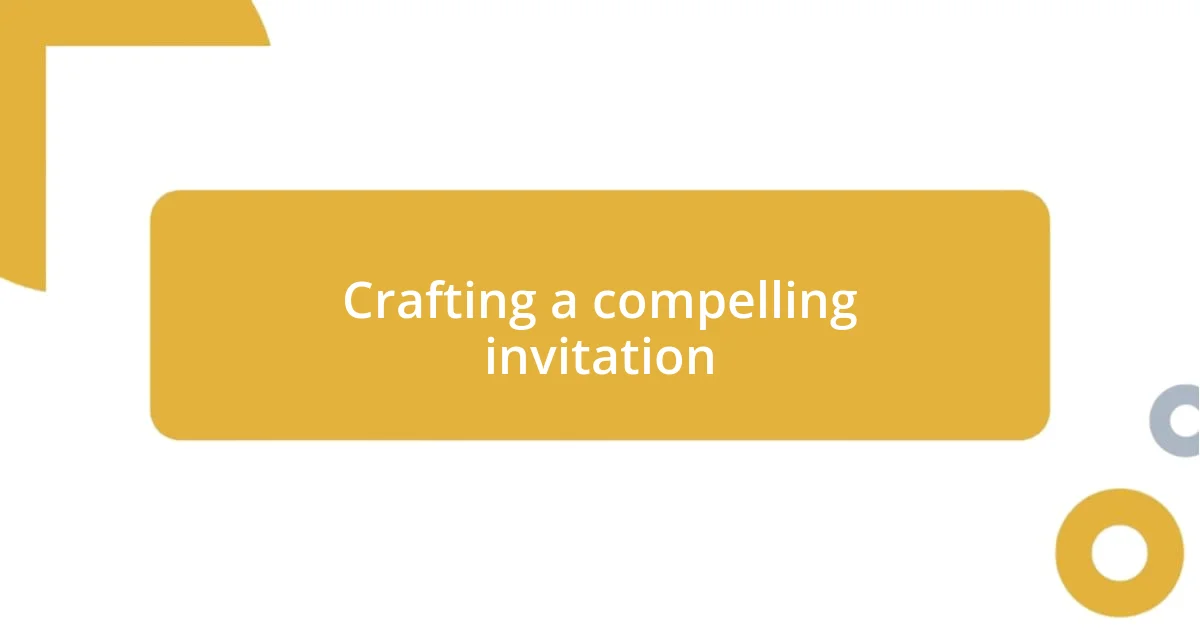
Crafting a compelling invitation
When it comes to crafting a compelling invitation, clarity and enthusiasm are paramount. I once created a group invite for a weekend beach bonfire, and instead of just sharing the logistics, I painted a picture of the experience. I described the warmth of the fire, the sound of waves crashing, and the delicious food we would enjoy together. This wasn’t just another gathering; it was a chance to make memories, and my friends could feel that excitement radiating through my words.
To ensure your invitation resonates, consider these key elements:
– Visual Appeal: Use vibrant language or images that evoke emotions related to the event.
– Personal Touch: Share a relatable story or previous experience to entice your friends.
– Simplicity: Be clear about the details—date, time, and location—without overwhelming them with too much information.
– Call to Action: Encourage a response by asking a question or inviting them to share what they’re most excited about.
By focusing on these aspects, your invitation can truly capture their interest and create a sense of anticipation.
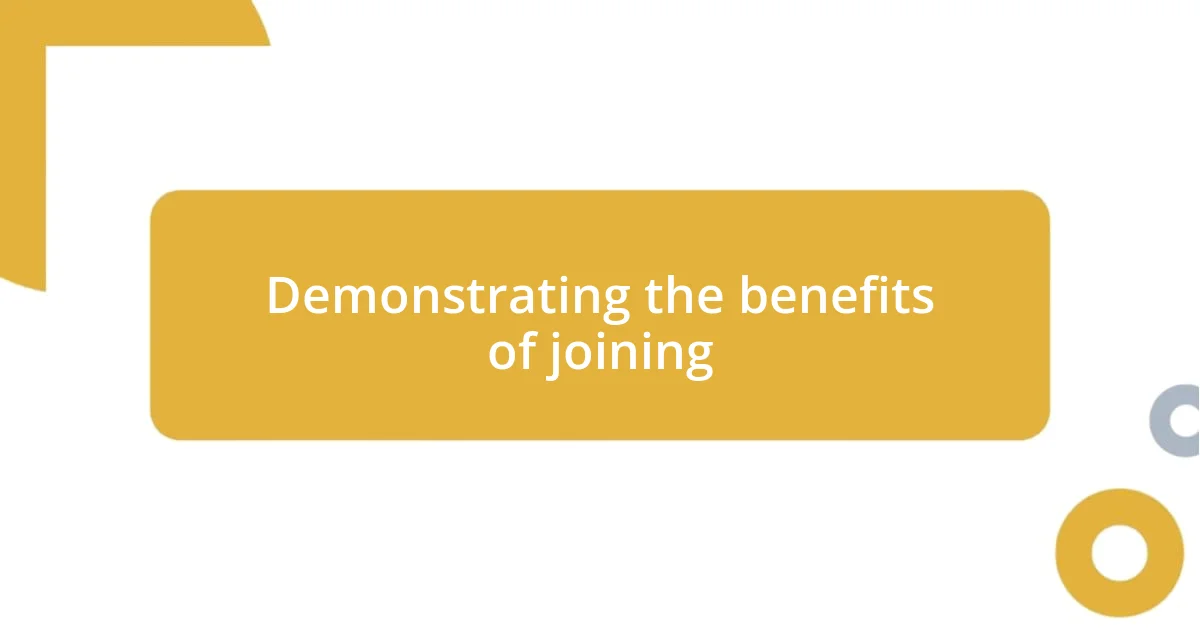
Demonstrating the benefits of joining
Demonstrating the benefits of joining can be a game changer in persuading friends to come along. A few summers ago, I organized a local hiking group and emphasized the health benefits to my friends. I shared how hiking not only promotes physical fitness but also offers a fantastic mental boost—something I personally felt after tackling a challenging trail. Just mentioning the fresh air and beautiful views got them excited about the idea of exploring nature together.
It’s important to highlight the social advantages too. I remember when we completed our first group hike. The laughter we shared over that peaceful lunch break made it clear that not only were we enjoying nature, but we were also strengthening our friendships. Have you ever realized how experiences shared outdoors can create some of your best memories? This social aspect truly appealed to my friends, and they were eager to join in future adventures.
Another effective approach is to illustrate the personal growth opportunities that come with joining a group. When I invited friends to join a book club, I talked about how discovering new perspectives through diverse readings could spark our creativity. I shared my excitement about discussing different themes and characters, which, frankly, opened my mind to thoughts I hadn’t considered before. Seeing them light up at the prospect of expanding our horizons together felt incredibly rewarding!
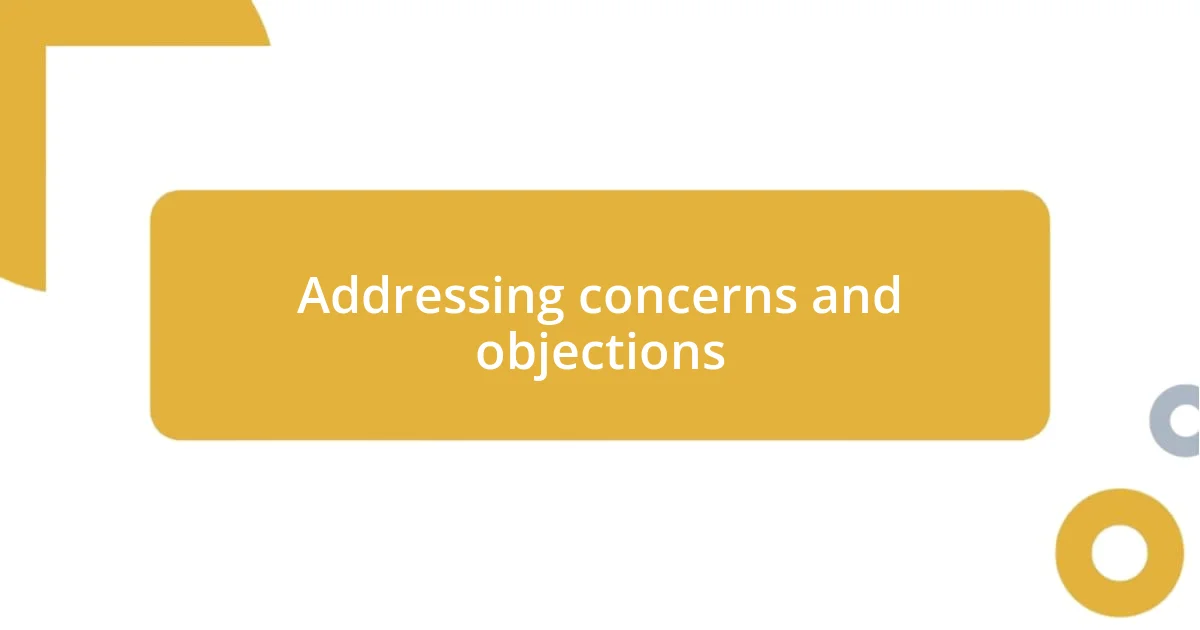
Addressing concerns and objections
Addressing the concerns of my friends was crucial when inviting them to join me. I remember a time when some were hesitant about going camping, worried about the discomfort of sleeping outdoors. Rather than dismissing their fears, I openly acknowledged their concerns and shared how I had once felt the same. I painted a vivid picture of a cozy camp setup, complete with comfortable sleeping bags and a warm fire, emphasizing that it would be more about adventure and camaraderie than hardship.
It’s fascinating how often misconceptions can prevent us from trying something new. A friend once expressed doubts about joining a pottery class, thinking it might be too challenging. I shared my early struggles and how, despite those initial difficulties, the joy of creating something tangible was worth every moment of my mistakes. By showing that everyone has a learning curve, I was able to reassure her that it was okay to not be perfect right away, and that we would learn and laugh together through the process.
Ultimately, I’ve found that being transparent about concerns often opens the door to deeper conversations. When discussing a group road trip, I acknowledged that some were worried about costs and time commitments. So, I took it upon myself to create a budget-friendly plan and mapped out a flexible schedule. This not only eased their worries but also fostered a sense of teamwork—didn’t it feel great to solve problems together? In doing so, I learned that addressing objections head-on can turn reluctance into excitement, making it a win-win for everyone involved.
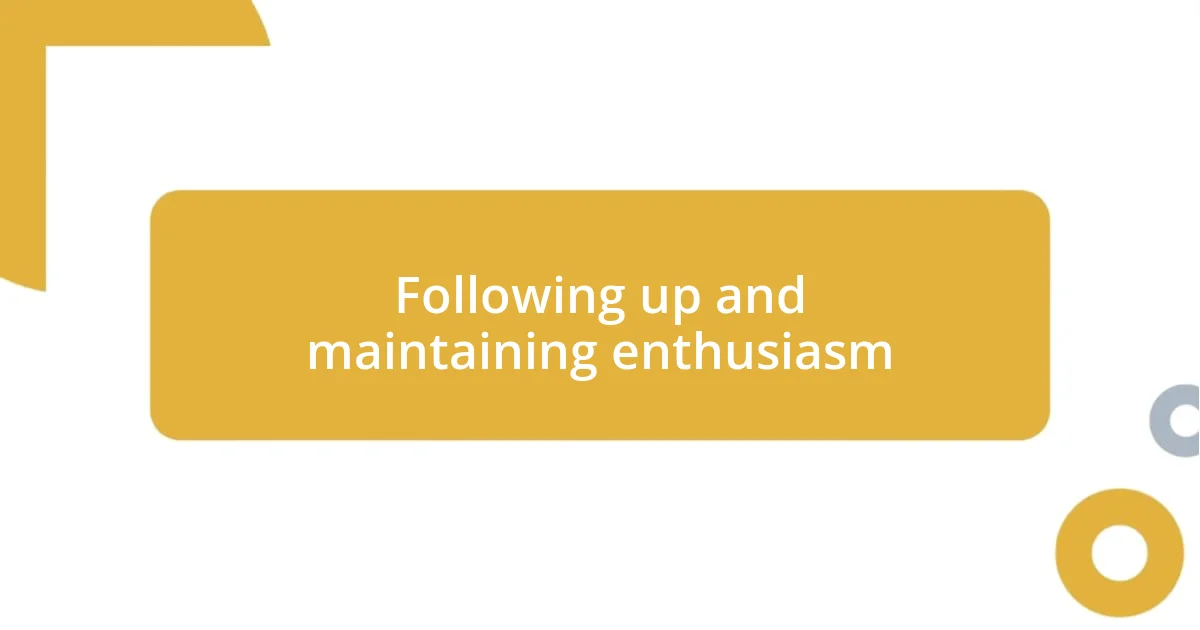
Following up and maintaining enthusiasm
Maintaining enthusiasm after the initial invitation is essential for keeping the momentum going. I remember once after organizing a weekend beach outing, I sent out a fun group chat message filled with pictures from our last trip. Those vibrant images of us laughing in the sun reignited everyone’s excitement. Isn’t it amazing how a shared memory can instantly transport us back to those enjoyable moments and make us yearn for more?
I also learned that consistency matters. After inviting friends to join me for a weekly game night, I established a routine by checking in each week, asking what games they’d like to play next. By actively involving them in the planning, I noticed their eagerness to participate grew. It made me realize that being engaged in the process not only bolstered their interest but also built a sense of ownership over our gatherings. Have you ever felt more excited about something when you had a hand in shaping it?
Sometimes, a little surprise can keep enthusiasm bubbling. For a recent hiking trip, I decided to send out personalized notes with trail maps and snack ideas. Adding little touches made it feel special, and my friends’ reactions were priceless. Seeing their enthusiasm sparked my own excitement further, reminding me that cultivating joy often stems from the connections we nurture. So, how can you incorporate fun surprises in your events to keep those spirits high?










